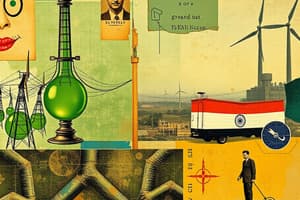Podcast
Questions and Answers
What is green hydrogen?
What is green hydrogen?
- Hydrogen produced through the same process as grey hydrogen but with captured CO2
- Hydrogen produced by splitting natural gas into hydrogen and CO2
- Hydrogen produced through the same process as blue hydrogen but with captured CO2
- Hydrogen produced by splitting water using electrolysis powered by renewable energy sources (correct)
What is the difference between grey and blue hydrogen?
What is the difference between grey and blue hydrogen?
- Grey hydrogen is produced with captured CO2, while blue hydrogen is produced without capturing CO2
- Grey hydrogen is produced from renewable energy sources, while blue hydrogen is produced from natural gas
- Grey hydrogen is produced without capturing CO2, while blue hydrogen is produced with captured CO2 (correct)
- Grey hydrogen is produced from natural gas, while blue hydrogen is produced from renewable energy sources
What is the main advantage of green hydrogen over grey hydrogen?
What is the main advantage of green hydrogen over grey hydrogen?
- Easier transport
- Significantly lower carbon emissions (correct)
- Higher energy density
- Lower production costs
What is the challenge with transporting hydrogen?
What is the challenge with transporting hydrogen?
What is electrolysis?
What is electrolysis?
What are some applications for green hydrogen?
What are some applications for green hydrogen?
Why are fuel-cell vehicles still a challenge?
Why are fuel-cell vehicles still a challenge?
What is the range of sizes for electrolyzers?
What is the range of sizes for electrolyzers?
What is green hydrogen?
What is green hydrogen?
Which of the following is not a type of hydrogen?
Which of the following is not a type of hydrogen?
What is the difference between blue and grey hydrogen?
What is the difference between blue and grey hydrogen?
What is the main advantage of green hydrogen over grey hydrogen?
What is the main advantage of green hydrogen over grey hydrogen?
What is the main challenge in transporting hydrogen?
What is the main challenge in transporting hydrogen?
What is the promising option for carbon-free hydrogen production from renewable and nuclear resources?
What is the promising option for carbon-free hydrogen production from renewable and nuclear resources?
What are the applications for green hydrogen?
What are the applications for green hydrogen?
What is the challenge with fuel-cell vehicles?
What is the challenge with fuel-cell vehicles?
Flashcards are hidden until you start studying
Study Notes
Green Hydrogen: Advantages, Classification, Challenges, and Applications
- Hydrogen is a clean energy source that emits only water when used.
- Green hydrogen is produced by splitting water using electrolysis powered by renewable energy sources like wind or solar.
- Grey hydrogen is produced by splitting natural gas into hydrogen and CO2, but the CO2 is not captured, while blue hydrogen is produced through the same process, and the CO2 is captured and stored.
- Green hydrogen has significantly lower carbon emissions than grey hydrogen, which makes up the bulk of the hydrogen market.
- Green hydrogen production is less than 0.1% of total hydrogen production but can help decarbonize hard-to-electrify sectors such as steel and cement.
- The flammability and lightness of hydrogen require proper handling, but its low concentration has similar flammability potential as other fuels.
- Transporting hydrogen is challenging due to its low density, requiring compression or liquefaction, and transport through pipelines, tanker trucks, tube trailers, rail, or barge.
- Green hydrogen is renewable, storable, and transportable, making it a key component of the energy transition towards carbon neutrality.
- Electrolysis is a promising option for carbon-free hydrogen production from renewable and nuclear resources, using electricity to split water into hydrogen and oxygen.
- Electrolyzers range in size from small, appliance-size equipment to large-scale, central production facilities.
- Applications for green hydrogen include energy storage, fuel-cell vehicles, and decarbonizing residential and commercial heating systems.
- Fuel-cell vehicles remain a challenge due to the cost-competitiveness of battery-powered cars, while mixing green hydrogen into natural gas can reduce carbon content in places where natural gas prices are relatively high.
Green Hydrogen: Advantages, Classification, Challenges, and Applications
- Hydrogen is a clean energy source that emits only water when used.
- Green hydrogen is produced by splitting water using electrolysis powered by renewable energy sources like wind or solar.
- Grey hydrogen is produced by splitting natural gas into hydrogen and CO2, but the CO2 is not captured, while blue hydrogen is produced through the same process, and the CO2 is captured and stored.
- Green hydrogen has significantly lower carbon emissions than grey hydrogen, which makes up the bulk of the hydrogen market.
- Green hydrogen production is less than 0.1% of total hydrogen production but can help decarbonize hard-to-electrify sectors such as steel and cement.
- The flammability and lightness of hydrogen require proper handling, but its low concentration has similar flammability potential as other fuels.
- Transporting hydrogen is challenging due to its low density, requiring compression or liquefaction, and transport through pipelines, tanker trucks, tube trailers, rail, or barge.
- Green hydrogen is renewable, storable, and transportable, making it a key component of the energy transition towards carbon neutrality.
- Electrolysis is a promising option for carbon-free hydrogen production from renewable and nuclear resources, using electricity to split water into hydrogen and oxygen.
- Electrolyzers range in size from small, appliance-size equipment to large-scale, central production facilities.
- Applications for green hydrogen include energy storage, fuel-cell vehicles, and decarbonizing residential and commercial heating systems.
- Fuel-cell vehicles remain a challenge due to the cost-competitiveness of battery-powered cars, while mixing green hydrogen into natural gas can reduce carbon content in places where natural gas prices are relatively high.
Studying That Suits You
Use AI to generate personalized quizzes and flashcards to suit your learning preferences.




